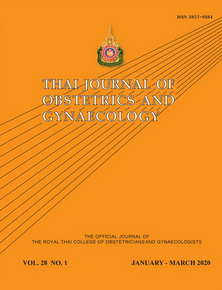The Association between Anterior Uterocervical Angle and Pregnancy between 16-24 Weeks of Gestation
Main Article Content
Abstract
Objective: To determine the association between gestational age and anterior uterocervical angles measured between 16 and 24 weeks of pregnancy.
Materials and Methods: A descriptive cross-sectional study was conducted among pregnant women at gestational age between 16-24 weeks, specifically in those who had access to the antenatal care clinic at Rajavithi hospital, Bangkok, Thailand, between July 2017 and March 2018. The women underwent anterior uterocervical angle measurements by means of transvaginal ultrasonography, which was performed by a well-trained sonographer. A correlation and regression analysis between the anterior uterocervical angles and the gestational weeks were carried out, while a predictive nomogram of the anterior uterocervical angle was developed for potential cases of angle changes associated with advancing gestational age.
Results: A total of 249 pregnancies (at least 15 measurements per week of gestation) were included in the study. The anterior uterocervical angle was not significantly associated with gestational age at 16 0/7 – 24 6/7 weeks (Pearson’s correlation, r = 0.038, p = 0.553). From the linear regression analysis, the parity was the significant factor associated with anterior uterocervical angle (p < 0.001). The mean ± standard deviation of anterior uterocervical angles were 96.1 ± 21.5 degrees and 108.9 + 20.0 degrees in the nulliparity and the multiparity groups, respectively.
Conclusion: The anterior uterocervical angle at 16-24 weeks was found to be independent of the gestational age. However, it was still significantly related to the parity.
Article Details
References
2. Celik E, To M, Gajewska K, Smith GC, Nicolaides KH, Fetal Medicine Foundation Second Trimester Screening G. Cervical length and obstetric history predict spontaneous preterm birth: development and validation of a model to provide individualized risk assessment. Ultrasound Obstet Gynecol 2008;31:549-54.
3. Goldenberg RL, Goepfert AR, Ramsey PS. Biochemical markers for the prediction of preterm birth. Am J Obstet Gynecol 2005;192(5 Suppl):S36-46.
4. Elimian A, Smith K, Williams M, Knudtson E, Goodman JR, Escobedo MB. A randomized controlled trial of intramuscular versus vaginal progesterone for the prevention of recurrent preterm birth. Int J Gynaecol Obstet 2016;134:169-72.
5. Jin Z, Chen L, Qiao D, Tiwari A, Jaunky CD, Sun B, et al. Cervical pessary for preventing preterm birth: a meta-analysis. J Matern Fetal Neonatal Med 2019;32:1148-54.
6. Zheng L, Dong J, Dai Y, Zhang Y, Shi L, Wei M, et al. Cervical pessaries for the prevention of preterm birth: a systematic review and meta-analysis. J Matern Fetal Neonatal Med 2019;32:1654-63.
7. Govindaswami B, Jegatheesan P, Nudelman M, Narasimhan SR. Prevention of Prematurity: Advances and Opportunities. Clin Perinatol 2018;45:579-95.
8. House M, Bhadelia RA, Myers K, Socrate S. Magnetic resonance imaging of three-dimensional cervical anatomy in the second and third trimester. Eur J Obstet Gynecol Reprod Biol 2009;144 Suppl 1:S65-9.
9. Myers KM, Feltovich H, Mazza E, Vink J, Bajka M, Wapner RJ, et al. The mechanical role of the cervix in pregnancy. J Biomech 2015;48:1511-23.
10. Arabin B, Alfirevic Z. Cervical pessaries for prevention of spontaneous preterm birth: past, present and future. Ultrasound Obstet Gynecol 2013;42:390-9.
11. Son M, Miller ES. Predicting preterm birth: Cervical length and fetal fibronectin. Semin Perinatol 2017;41:445-51.
12. Guzman ER, Walters C, Ananth CV, O’Reilly-Green C, Benito CW, Palermo A, et al. A comparison of sonographic cervical parameters in predicting spontaneous preterm birth in high-risk singleton gestations. Ultrasound Obstet Gynecol 2001;18:204-10.
13. Sochacki-Wojcicka N, Wojcicki J, Bomba-Opon D, Wielgos M. Anterior cervical angle as a new biophysical ultrasound marker for prediction of spontaneous preterm birth. Ultrasound Obstet Gynecol 2015;46:377-8.
14. Dziadosz M, Bennett TA, Dolin C, West Honart A, Pham A, Lee SS, et al. Uterocervical angle: a novel ultrasound screening tool to predict spontaneous preterm birth. Am J Obstet Gynecol 2016;215:376 e1-7.
15. Farras Llobet A, Regincos Marti L, Higueras T, Calero Fernandez IZ, Gascon Portales A, Goya Canino MM, et al. The uterocervical angle and its relationship with preterm birth. J Matern Fetal Neonatal Med 2018;31:1881-4.
16. Zarate-Kalfopulos B, Romero-Vargas S, Otero-Camara E, Correa VC, Reyes-Sanchez A. Differences in pelvic parameters among Mexican, Caucasian, and Asian populations. J Neurosurg Spine 2012;16:516-9.
17. Diniz CP, Araujo Junior E, Lima MM, Guazelli CA, Moron AF. Ultrasound and Doppler assessment of uterus during puerperium after normal delivery. J Matern Fetal Neonatal Med 2014;27:1905-11.
18. Mulic-Lutvica A, Bekuretsion M, Bakos O, Axelsson O. Ultrasonic evaluation of the uterus and uterine cavity after normal, vaginal delivery. Ultrasound Obstet Gynecol 2001;18:491-8.
19. van Veelen GA, Schweitzer KJ, van der Vaart CH. Ultrasound imaging of the pelvic floor: changes in anatomy during and after first pregnancy. Ultrasound Obstet Gynecol 2014;44:476-80.
20. Nizic D, Pervan M, Kos I, Simunovic M. [Flexion and version of the uterus on pelvic ultrasound examination]. Acta Med Croatica 2014;68:311-5.
21. Sosa-Stanley, J.N.; Bhimji, S.S. Anatomy, Pelvis, Uterus. In StatPearls (Internet); StatPearls Publishing LLC: Treasure Island, FL, USA, 2018. Available online: https://www.ncbi.nlm.nih.gov/books/NBK470297/ (accessed on 4 July 2018).


